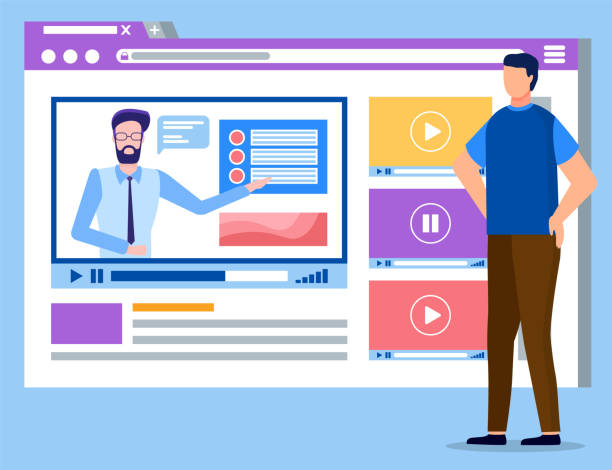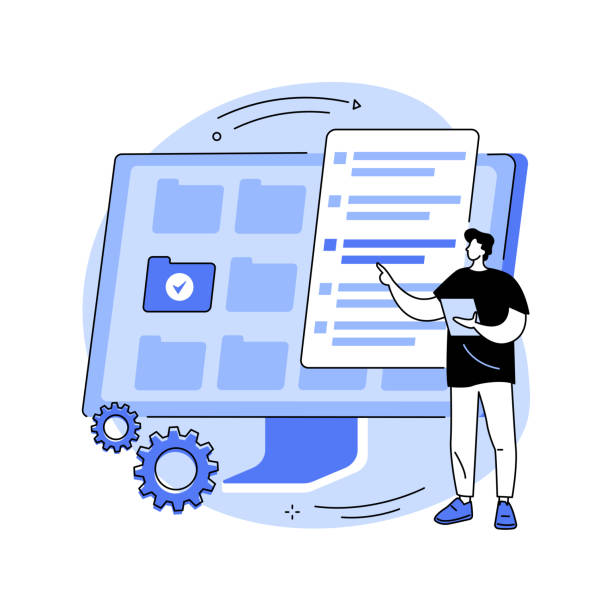Why Website Speed Matters? Understanding Its Impact on Business and User Experience

In today’s digital world, where the competition for user attention intensifies by the moment, website loading speed has become more important than ever.
It’s no longer enough to simply have a website; it must be fast, smooth, and user-friendly.
Have you ever thought about why speed is important to users? Various statistics show that if a site doesn’t load in under three seconds, more than half of its visitors will leave it.
This is a disaster for any business! This issue not only leads to a reduction in bounce rate but also directly impacts SEO and site ranking in search engines.
Google has clearly stated that site speed is a ranking factor, and slower sites appear lower in search results.
Furthermore, user experience (UX) is highly dependent on site speed.
A fast website conveys a sense of reliability and professionalism to the user, while a slow site can lead to frustration and distrust.
This is crucial not only for e-commerce sites, which directly impact conversion rates, but also equally important for blogs, news sites, and service platforms.
In fact, fast website design is a long-term investment that yields significant returns in the form of customer satisfaction, increased organic traffic, and ultimately, business growth.
The importance of this issue is such that it should be prioritized from the very initial stages of web design and development.
Ignoring speed means losing significant potential in the online market and can severely reduce your competitiveness.
Does your company’s website perform as it deserves for your brand? In today’s competitive world, your website is your most important online tool. RasaWeb, a specialist in professional corporate website design, helps you to:
✅ Attract customer credibility and trust
✅ Convert website visitors into customers
⚡ Get a free consultation!
Key Factors Affecting Website Speed: Components and Infrastructure

To achieve fast website design, one must first become familiar with the numerous factors that influence it.
Understanding these factors will help you implement effective optimization strategies.
One of the most important factors is the type and quality of hosting.
Poor or unsuitable hosting can be the main bottleneck for your site’s speed, even if you’ve written the best code in the world.
Cheap shared hosting is usually not suitable for high-traffic sites, and one should opt for dedicated hosting, VPS, or cloud hosting.
Another factor is images and media.
Large and unoptimized images constitute a significant portion of web page size and take a long time to load.
Using appropriate formats (like WebP), compression, and lazy loading are fundamental solutions for this challenge.
Furthermore, website coding also plays a crucial role.
Disorganized code, excessive scripts, and heavy plugins can severely reduce site speed.
Optimizing CSS, JavaScript, and HTML through minification and combining files has a significant impact on increasing speed.
The use of CDN (Content Delivery Network) to deliver content from the closest server to the user, and caching systems to store static content and reduce requests to the server, are other specialized solutions for improving website performance and speed.
Each of these factors, layer by layer, affects your site’s final speed and must be carefully reviewed and optimized to have a truly fast website.
Optimizing Images and Media: A Fundamental Step in Increasing Speed

Images and media files are undoubtedly among the most attractive parts of any website, but at the same time, they can also be its biggest slowing factor.
In the discussion of fast website design, image optimization is a vital and indispensable step.
Many websites, due to insufficient knowledge in this area, upload images with very large dimensions and file sizes, which results in slow loading and a poor user experience.
The first principle in this regard is using correct dimensions.
Always upload images with the dimensions they are intended to be displayed on the site; not larger.
Next, it’s time for compression.
There are numerous online tools and plugins that significantly reduce image file size without noticeable loss of quality.
New formats like WebP offer better performance than JPEG and PNG and can reduce file size by an additional 25-35%.
Lazy Loading is also a very effective technique.
With this method, images are only loaded when the user scrolls to the relevant section of the page, not all images at the very beginning of the page load.
This significantly increases the initial loading speed, especially on pages with extensive content and numerous images.
Finally, using a CDN to host images and media can help distribute content from the closest server to the user, further increasing loading speed.
These actions not only help improve site speed but also reduce server bandwidth consumption.
Attention to detail in media optimization is a fundamental component in achieving high-speed web design and should never be overlooked.
| Image Format | Advantages | Disadvantages | Best Use for Fast Website Design |
|---|---|---|---|
| JPEG/JPG | High compression for complex photos, broad browser support | No transparency (Alpha Channel) support, quality loss with high compression | Real photos, high-detail images |
| PNG | Transparency support, high quality without loss in compression | Higher file size compared to JPEG for photos, limited animation support | Logos, icons, images with transparent backgrounds, web graphics |
| WebP | Very high compression with quality retention, support for transparency and animation (Lossy and Lossless) | Weaker support in older browsers | For almost all image types, ideal for reducing size and improving speed |
| SVG | Vector images, unlimited scalability without quality loss, very small file size | Only for vector graphics, not real photos | Icons, logos, charts, simple graphics |
The Role of Optimized Coding and Frameworks in High-Speed Web Design

In addition to images and hosting, the quality of your website’s coding plays a vital role in its speed.
Optimized and principled coding is the foundation of fast website design.
This means writing clean, concise, and efficient code for HTML, CSS, and JavaScript.
One of the most important solutions is Minification and file concatenation.
Minification means removing whitespace, comments, and extra characters from CSS and JavaScript files, which reduces file size and, consequently, increases loading speed.
Combining several CSS or JS files into one also reduces the number of HTTP requests to the server, which is itself an important factor in increasing speed.
Using modern and lightweight frameworks can also accelerate development and code optimization.
Frameworks like React, Vue, or Next.js, due to their component-based architecture and server-side rendering (SSR) or static site generation (SSG) capabilities, can produce very fast and responsive websites.
Also, adhering to SEO-friendly principles in coding, such as proper use of semantic HTML tags and appropriate URL structure, helps search engines better understand and index your site, which indirectly impacts site speed and visibility.
Preventing multiple redirects, reducing the number of HTTP requests, and asynchronous loading of scripts are other advanced techniques that web developers should consider for achieving high performance in web design.
This is a set of technical measures that make a website optimized and fast in terms of coding.
Is your current e-commerce site design not generating the sales you expect?
RasaWeb is a specialist in professional e-commerce site design!
✅ An attractive and user-friendly site with the goal of increasing sales
✅ High speed and security for an ideal shopping experience⚡ Get a free consultation for online store design with RasaWeb!
Choosing the Right Host and CDN: The Foundation of a Fast Website

One of the most important decisions on the path to fast website design is choosing suitable hosting.
Hosting serves as a home for your website in the internet world, and its quality directly impacts your site’s speed, stability, and security.
There are various types of hosting, including shared hosting, VPS, dedicated servers, and cloud hosting.
Shared hosting is often the cheapest option, but its resources are shared among multiple websites, and if one of them has high traffic, your site’s speed will also be affected.
For websites seeking high performance and more control, VPS or dedicated servers are considered better options.
Cloud Hosting is also ideal for sites with variable and high traffic due to its high scalability and load distribution capabilities.
In addition to hosting, using a Content Delivery Network (CDN) is also crucial for increasing site speed, especially for users accessing your site from distant geographical locations.
A CDN copies your website’s static content (such as images, CSS, and JavaScript) to various servers worldwide.
When a user from a specific geographical location requests content, the CDN delivers that content from the nearest server to the user, which significantly reduces loading time.
This technique not only increases speed but also helps with site stability during peak traffic by distributing the traffic load, and also provides an additional layer of security.
Companies like Cloudflare and Akamai are prominent providers of CDN services.
Choosing the right host and CDN provides a strong foundation for building a high-speed and reliable website.
Website Speed Analysis and Measurement Tools: How to Evaluate Your Performance?

After implementing fast website design solutions, the next step is to evaluate performance and measure the effectiveness of the changes.
Without proper tools for speed analysis, you are moving in the dark and don’t know which sections need further optimization.
Fortunately, powerful tools are available to help you examine your site’s performance from various angles.
Google PageSpeed Insights is one of the most popular and important of these tools.
This tool not only evaluates your site’s speed on desktop and mobile but also provides suggestions for performance improvement based on Google’s Core Web Vitals metrics (such as LCP, FID, CLS).
These metrics are directly related to actual user experience.
Another tool is GTmetrix, which provides very comprehensive reports on site performance.
This tool uses PageSpeed and YSlow for analysis and provides scores for each of these indicators along with detailed recommendations for troubleshooting.
You can also test your site’s performance in different geographical locations and with various browsers.
Lighthouse, which is directly built into Chrome’s developer tools, is an automated auditing tool that not only checks speed but also evaluates metrics related to accessibility, best practices, and SEO.
Regular use of these tools is crucial for continuous monitoring and improvement of site speed.
They allow you to not only identify existing problems but also measure the impact of your optimization efforts and continuously strive to achieve the fastest possible user experience.
Caching and Data Compression: Advanced Solutions for Speeding Up Your Website

To reach peak speed in fast website design, beyond initial optimizations, one must turn to more advanced solutions like caching and data compression.
Caching means storing a copy of your website’s content (such as HTML pages, images, CSS, and JavaScript) closer to the user or on the server itself, so that in subsequent visits, there’s no need to reload or reprocess from scratch.
This significantly reduces the number of requests to the server and the volume of data transferred.
Caching can occur at several levels: Browser Caching, which stores content on the user’s device; Server-Side Caching, which includes object caching, page caching, and database caching; and caching using a CDN, as mentioned earlier.
One common server-side caching method is using tools like Redis or Memcached for database caching, and using caching plugins for content management systems like WordPress.
Alongside caching, data compression also plays a key role.
Gzip compression is one of the most widely used methods that significantly reduces the transfer time of text files (HTML, CSS, JavaScript) from the server to the user’s browser by reducing their size.
This allows data to be sent and received faster, resulting in a noticeable increase in page loading speed.
Enabling Gzip is usually possible through server settings or the .htaccess file.
The intelligent combination of caching and compression is a powerful strategy for achieving ultimate website speed, which creates a significant difference in user experience and is essential for any website seeking superior performance.
| Caching Type | Storage Location | Advantages | Disadvantages/Challenges | Impact on Site Speed |
|---|---|---|---|---|
| Browser Caching | User’s device (browser) | Reduces repeated requests to the server, high loading speed for returning visits | Content updates might reach the user with a delay, requires setting HTTP headers | Very effective for returning visitors |
| Server-Side Caching | Website host server | Reduces load on server and database, increases speed for all users | Implementation complexity, requires cache management and clearing | Effective for all users, even new visitors |
| CDN Caching | Distributed servers worldwide | Fast content delivery to geographically distant users, reduces load on the origin server | Higher cost, might not be necessary for small websites | Very effective for international users |
Security and Speed: The Close Relationship Between These Two Concepts in Web Design

In the discussion of fast website design, the focus is often on technical optimizations, but the vital role of security should not be overlooked.
Security and speed are two sides of the same coin and have a close relationship.
A secure website not only protects user information and sensitive data but can also indirectly help improve speed.
The most important step in this regard is using the HTTPS protocol.
The HTTPS protocol, activated with an SSL/TLS certificate, encrypts traffic between the user’s browser and the server.
In addition to increasing trust and improving SEO (Google considers HTTPS a ranking factor), HTTP/2, which is usually accompanied by HTTPS, brings significant performance improvements.
This protocol enables parallel requests and reduces communication overhead, resulting in faster page loading.
On the other hand, excessive security measures or improper configuration of firewalls and security plugins can also inadvertently reduce site speed.
For example, some Web Application Firewalls (WAFs) might process each request with a delay before it reaches the main server.
Therefore, a balance between security and performance must be established.
Choosing lightweight and efficient security plugins, instead of heavy and feature-rich ones, is recommended.
Also, regularly updating the content management system, plugins, and site theme not only addresses security vulnerabilities but often includes performance improvements as well.
Ignoring security can lead to cyberattacks, site downtime, and ultimately, loss of users and site ranking, all of which directly affect website speed and credibility.
Consequently, for high-speed and stable web development, security must be an inseparable part of the design process.
Do you dream of a thriving online store but don’t know where to start?
RasaWeb is your comprehensive e-commerce website design solution.
✅ Attractive and user-friendly design
✅ Increased sales and revenue⚡ Get a free consultation
Future Trends in Fast Website Design: Are AMP and PWA the Ultimate Solution?

The world of the web is rapidly evolving, and every day we see the emergence of new technologies to improve user experience and speed.
In the discussion of fast website design, two important trends that have attracted much attention in recent years are Accelerated Mobile Pages (AMP) and Progressive Web Apps (PWA).
Will these be the ultimate solution for all website speed problems? AMP is an open-source project introduced by Google to create very fast web pages on mobile devices.
AMP pages are optimized using a restricted subset of HTML, CSS, and JavaScript and are often served through Google caches, providing near-instant loading.
For news sites and blogs with static content, AMP can significantly increase loading speed and improve the mobile user experience.
On the other hand, Progressive Web Apps (PWA) pursue a different approach.
PWAs aim to combine the best features of web and native applications.
A PWA can work offline, send push notifications, and even be added to the phone’s home screen without needing installation from app stores.
These capabilities are made possible thanks to Service Workers and the Application Shell concept.
PWAs, by offering a very smooth and fast user experience even in poor network conditions, can play an important role in the future of designing and building fast websites.
While AMP focuses more on static content and initial loading time, PWA is suitable for providing a deeper, app-like experience.
Neither of these is necessarily the ultimate solution for all types of websites, but both are powerful tools in the web developers’ toolbox for achieving the fastest possible online experience and should be evaluated based on the website’s needs and goals.
The Importance of Responsiveness and Mobile Design in Today’s Website Speed

In the current era, where most users access the internet via mobile devices, Responsive Design and the Mobile-First approach are not just an advantage, but a necessity for fast website design.
Google has also clearly emphasized the importance of this topic and implemented the mobile-first indexing algorithm, meaning your site’s mobile version holds more importance for ranking in search results.
A responsive site is designed to automatically adapt to the user’s screen size (whether desktop, tablet, or mobile) and provide the best user experience.
This includes adjusting the size of images, fonts, element layouts, and menus.
But merely being responsive is not enough; it must be ensured that the mobile version of the site is as fast and optimized as the desktop version.
Loading unnecessary code or high-resolution images on mobile devices can severely reduce speed.
Therefore, in the mobile-first approach, design and optimization are first performed for small devices, and then gradually, additional features and elements are added for larger screens.
This approach ensures that your site is designed from the outset for the fastest loading in a mobile environment.
Using CSS media queries to load resources appropriate for screen size, optimizing fonts for mobile, and removing heavy scripts that are not essential on mobile are among the actions that contribute to high-speed web design for mobile.
Neglecting mobile design and its speed not only disrupts the user experience for a large segment of the audience but can also seriously damage your site’s ranking in search engines.
Frequently Asked Questions
| Row | Question | Answer |
|---|---|---|
| 1 | What is fast website design? | Fast website design refers to a process where a functional and optimized website is launched in the shortest possible time, without sacrificing quality or performance. |
| 2 | What factors affect website design speed? | Using ready-made Content Management Systems (CMS) like WordPress, optimized ready-made templates, visual design tools, the designer’s experience, and effective communication with the client. |
| 3 | Does fast website design always mean reduced quality? | No, with proper planning, using optimized tools, and standard techniques, a high-quality website can be designed in a short time. |
| 4 | What types of websites are more suitable for fast design? | Small corporate websites, blogs, online resumes, landing pages, and online stores with limited products. |
| 5 | What is the role of CMSs (like WordPress) in fast design? | CMSs significantly speed up the design and development process by providing templates, plugins, and an easy-to-use administration panel. |
| 6 | Does fast website design cost less? | Usually, yes. Due to reduced designer working hours and the use of ready-made resources, costs can be significantly lowered. |
| 7 | What information is needed from the client for fast design? | Contact information, logo, textual content, images, website goals, and any specific customization needs. |
| 8 | Do quickly designed websites have future scalability? | Yes, especially if built with popular CMSs like WordPress, new features can easily be added to them in the future. |
| 9 | What are the advantages of fast website design for businesses? | Faster market entry, testing new ideas with minimal risk, cost reduction, and the ability to launch immediate marketing campaigns. |
| 10 | What is the difference between fast website design and “ready-made websites”? | Fast design involves the process of designing and implementing based on client needs, even if it uses ready-made tools. However, “ready-made websites” usually refer to platforms where you simply input your information and receive a predefined website. |
And other services of RasaWeb Advertising Agency in the field of advertising
Smart Marketing Automation: Designed for businesses looking to manage campaigns through marketing automation.
Smart Brand Identity: A dedicated service for growth in sales based on attractive UI design.
Smart SEO: A fast and efficient solution for increasing website traffic with a focus on attractive UI design.
Smart Advertising Campaign: A professional solution for digital branding with a focus on smart data analysis.
Smart Brand Identity: Revolutionize click-through rates with the help of smart data analysis.
And over a hundred other services in the field of internet advertising, advertising consulting, and organizational solutions
Internet Advertising | Advertising Strategy | Advertorial
Resources
The Importance of Website Speed in SEO
Image Optimization for Website Speed
The Impact of UX on Competitive Advantage
Fast Website Design Frameworks
? Are you ready to advance your business in the digital world? RasaWeb Afarin’s expert team, by providing comprehensive digital marketing services, including SEO-optimized website design, helps you achieve your big goals and have a powerful online presence. For consultation and to start your business’s digital transformation, contact us today.
📍 Tehran, Mirdamad Street, next to Bank Markazi, Kazeroon Jonubi Alley, Ramin Alley, No. 6




